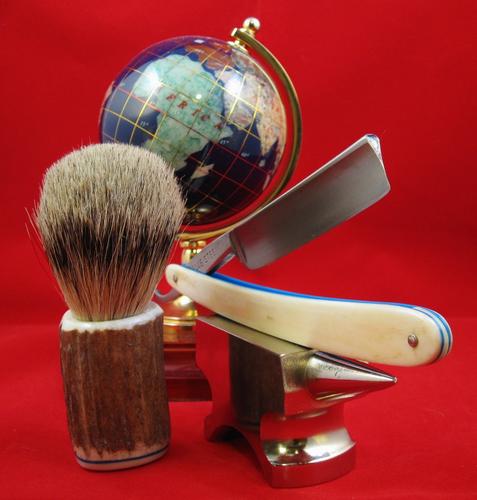Results 1 to 7 of 7
Thread: making striped scales
-
08-15-2012, 03:21 PM #1Junior Member

- Join Date
- May 2011
- Posts
- 2
Thanked: 0 making striped scales
making striped scales
I am just getting into this world and I saw the guide for making a fancy lined wedge. The basic instruction for that was glue metal plates to the outside of the wedge and proceed as normal. Could that process be used for scales? Could I put 2 or more pieces of micarta together with glue and then make the scales out of the combined pieces? Or would the pieces come apart with the bend you put in them?
-
08-15-2012, 03:59 PM #2At this point in time...




- Join Date
- Jun 2007
- Location
- North Idaho Redoubt
- Posts
- 27,063
- Blog Entries
- 1
Thanked: 13249
Yes you can..
BUT
You have already recognized the issue you have to have the inside piece as flexible or more flexible then the outside piece Celticcrusader aka Jamie has tis process down pat using wood on the outside and acrylic on the inside (search his stuff out) Another way to do this is by creating what is often called a "Mechanical Lock" which means that the glue/epoxy dries it creates a "lock" between the two sides drilling opposing holes in each material is just an example of how it can be done..
Now the next issue to over come is weight, when you start adding materials and the weight of the glue the scales start to take on weight, and they start being built with beauty being put ahead of function, try and balnce those two things and the razor will balance better in the hand..
There is also very thin and light G-10 available out there that works well like these with Blue G-10 and Vintage Ivory

Good LuckLast edited by gssixgun; 08-15-2012 at 04:03 PM.
-
08-15-2012, 08:38 PM #3Junior Member

- Join Date
- May 2011
- Posts
- 2
Thanked: 0
The very thin and light g10 is what I was thinking of using and they should have no issue with being too rigid. The issue I was most worried about would be the 2 pieces splitting away from each other.
-
08-15-2012, 09:56 PM #4At this point in time...




- Join Date
- Jun 2007
- Location
- North Idaho Redoubt
- Posts
- 27,063
- Blog Entries
- 1
Thanked: 13249
-
08-20-2012, 08:34 PM #5

Although you weren't talking about me when you said "Maybe Jamie will share what he uses" but as my name is Jamie...
when I did the JR Torry in wood and acrylic I used the same method as Glen, two part epoxy and dimples. Although it is not two materials lined it has survived the stress of pinning without peeling apart, but it took a couple tries to get it right...
Attachment 104277
-
08-22-2012, 06:37 AM #6

As Glen said that inside curve is where the real applied tension is going to be constant, well as long as both your surfaces are perfectly flat and clean, but also lightly keyed I use a very light going over with 300 grit, you can use epoxy or CA industrial strength both work fine make sure they are both clamped together with even pressure leave overnight i've never had a problem, certain woods obviously react differently when trying to bond them to another surface some are more porous than others, good luck with your project.
Jamie“Wherever you’re going never take an idiot with you, you can always find one when you get there.”
-
08-22-2012, 06:27 PM #7< Banned User >

- Join Date
- May 2012
- Location
- Forest Park
- Posts
- 282
Thanked: 44
I don't know about you guys, but I use fast drying gorilla glue to bond all my lined scales, and have never had an issue. It expands and fills all voids and pores. I used to use CA but found it inferior for the purpose. But keep in mind I'm using bone and wood or wood and wood most of the time. I have had issues trying to use horn bonded to wood...


 2Likes
2Likes LinkBack URL
LinkBack URL About LinkBacks
About LinkBacks






 Reply With Quote
Reply With Quote
 I use a 2 part epoxy and use a burr to create interlocking dimples for the glue to grab more.. Maybe Jamie will share what he uses...
I use a 2 part epoxy and use a burr to create interlocking dimples for the glue to grab more.. Maybe Jamie will share what he uses...

